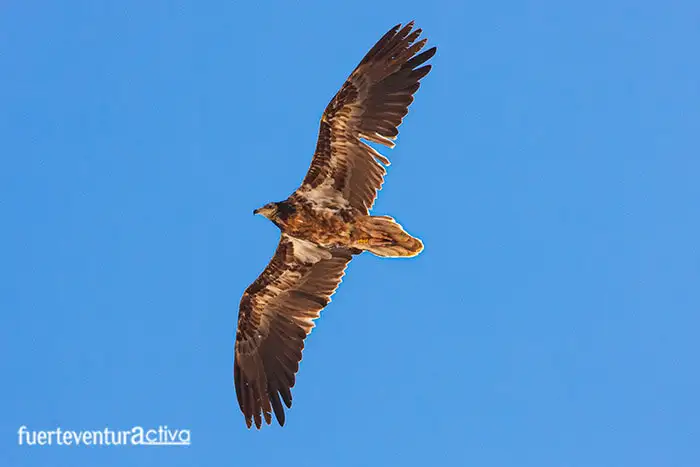What to see in Fuerteventura ?
El Guirre: master and lord of the Majorero skies
Fuerteventura is a place of great ornithological value. It is home to the largest number of bird species in the Canary archipelago. It has more than 300 species of birds cited so far. Among them we highlight some of great interest, such as the Canarian stonechat, the Canarian houbara, the Saharan runner and the Ortega ganga. But if there is an emblematic bird that crosses the skies of Fuerteventura, that is the Majorero guirre (Neophron percnopterus majorensis), a subspecies of Egyptian vulture that is exclusive to the Canary Islands and, therefore, unique in the world.
In Fuerteventura lives the largest population of guirres in the entire archipelago. Its wingspan of 1.6 meters and its characteristic plumage (black, white and yellow), mean that this bird of prey does not go unnoticed.
The guirre: a sacred bird.

The guirre was a sacred bird for the aborigines of all the Canary Islands. They considered them the representation of the soul of their ancestors, who flew over the skies to watch over them and thus be able to protect them.
The aborigines performed rituals in which they offered dead animals to the guirres in exchange for their protection. Before the Franco-Norman conquest, only people of great importance such as shamans and kings could adorn themselves with their feathers.
In Fuerteventura, the guirre also has great cultural importance. Legends about this little vulture have lasted through the centuries, thanks to oral tradition. One of these legends relates the guirre with the myth of the Phoenix Bird. He assures that when guirres feel death, they fly into the sky and vanish into thin air.
Apparently and according to the chronicles of the conquest, back in the early fifteenth century, the guirres showed great confidence in human beings. The conqueror Jean de Betancourt recorded that these birds “… always go among the people and do not leave any dirt”
The guirre: in the field

The guirres are carrion birds. They fly over the skies looking for landfills where they can find organic garbage.
In the past they populated all the islands of the archipelago, but an undeserved bad reputation among the people of the countryside, together with the use of poisons and the installation of power lines caused, in the mid-20th century, its almost total disappearance.
Fortunately, the idea that guirres attacked cattle was banished decades ago. Today the guirre is considered, by farmers and ranchers, as one of the noblest and most useful birds in the field. It is the only carrion-eating bird of prey in the Canary Islands that is beneficial to man since it cleans the field of dead animals, thus preventing the spread of diseases and the contamination of the waters.
The resurgence of guirre
After becoming extinct in most of the Canary Islands, in the 1980s, Fuerteventura, Lanzarote and the islets constituted the last refuge of the guirre in the Canary Islands. With just 20 pairs in the early 2000s, a recovery plan came just in time and laid the groundwork for the island to now number some 400 individuals again.
How to identify the guirre?

The silhouette of the guirre adult is unmistakable: the chest, throat and most of the wings are bone-white, with a wide band of black feathers on the wings. The tail is white and wedge-shaped. The face is yellow and the head pointed. The beak, which it uses to tear its prey to pieces, is long and curved, black in color.
At the back of the head it has a kind of “feather”.
The legs are bare of plumage and are usually gray, although they also have flesh-yellow tones, with black and weak nails. The female is somewhat larger than the male.

The young guirres show a dark brown plumage. They take 5 to 6 years to acquire their full adult plumage.
Where does the word guirre come from?
The word guirre already appears in historical documents from the end of the 16th century. At first it was thought that this word came from an aboriginal word, of Berber origin. However, both the Historical Dictionary of Canary Spanish and the Differential Dictionary of Spanish in the Canary Islands (DDEC) are more inclined to think that the origin of the word guirre is onomatopoeic, specifically from the Salamancan voice guirle, guirre, guirri(o) .
Where can you see and photograph the Guirre Majorero?

Although the guirres nest in areas where rocky escarpments are abundant, it is not necessary to climb the mountains to observe the flight of these birds, as they are all over the island, especially where there are goat farms.
The Cabildo de Fuerteventura has two middens: one in Tiscamanita and another in Villaverde, where it is easier to see the guirres.
Tips for when you go out into the field:

The reproductive period of the guirre is from April to July. These birds are in danger of extinction. They are very susceptible to any change in their environment. If they are stressed, they can abandon their young. And we don’t want that, right? Therefore, when we go out into the field, especially during the guirre breeding season, it would be good to take the following aspects into consideration.
- Do not leave the enabled trails.
- Make as little noise as possible when walking and do not raise your voice in areas where there may be guirre nests.
- Dress in clothes with earthy, green or gray tones. Birds of prey see colors very well and are easily startled when observing colors with a lot of contrast, such as white.
- If you pass near a nest, stop and turn around on your steps, along the same path.
Fuerteventura3 Fuerteventura8





